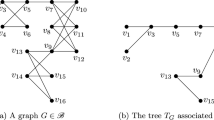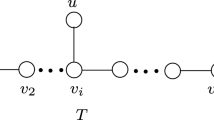Abstract
Baker and Wang define the so-called Bernardi action of the sandpile group of a ribbon graph on the set of its spanning trees. This potentially depends on a fixed vertex of the graph but it is independent of the base vertex if and only if the ribbon structure is planar, moreover, in this case the Bernardi action is compatible with planar duality. Earlier, Chan, Church and Grochow and Chan, Glass, Macauley, Perkinson, Werner and Yang proved analogous results about the rotor-routing action. Baker and Wang moreover showed that the Bernardi and rotor-routing actions coincide for plane graphs.
We clarify this still confounding picture by giving a canonical definition for the planar Bernardi/rotor-routing action, and also a canonical description of the isomorphism between sandpile groups of planar dual graphs. Our definition implies the compatibility with planar duality via an extremely short argument. We also uncover hidden symmetries of the problem by proving our results in the slightly more general setting of balanced plane digraphs.
Any balanced plane digraph gives rise to a trinity, i.e., a triangulation of the sphere with a three-coloring of the 0-simplices. Our most important tool is a group associated to trinities, introduced by Cavenagh and Wanless, and a result of a subset of the authors characterizing the Bernardi bijection in terms of spanning trees dual to arborescences.
Similar content being viewed by others
References
Y. An, M. Baker, G. Kuperberg and F. Shokrieh: Canonical representatives for divisor classes on tropical curves and the Matrix-Tree Theorem, Forum of Mathematics, Sigma 2 (2014), e24.
M. Baker and Y. Wang: The Bernardi process and torsor structures on spanning trees, Int. Math. Res. Not. 2017.
O. Bernardi: A characterization of the Tutte polynomial via combinatorial embedding, Ann. Combin. 12 (2008), 139–153.
O. Bernardi: Tutte Polynomial, Subgraphs, Orientations and Sandpile Model: New Connections via Embeddings, Electron. J. Combin. 15 (2008), R109.
S. R. Blackburn and T. A. McCourt: Triangulations of the sphere, bitrades, and Abelian groups, Combinatorica 34 (2014), 527–546.
N. J. Cavenagh and I. M. Wanless: Latin trades in groups defined on planar triangulations, J. Algebr. Comb. 30 (2009), 323–347.
M. Chan, T. Church and J. Grochow: Rotor-routing and spanning trees on planar graphs, Int. Math. Res. Not. 11 (2015), 3225–3244.
M. Chan, D. Glass, M. Macauley, D. Perkinson, C. Werner and Q. Yang: Sandpiles, Spanning Trees, and Plane Duality, SIAM J. Discrete Math. 29 (2015), 461–471.
R. Cori and D. Rossin: On the Sandpile Group of Dual Graphs, Europ. J. Combinatorics 21 (2000), 447–459.
C. Ding: The rotor routing torsor and the Bernardi torsor disagree for every non-planar ribbon graph, arXiv:2103.01137.
A. Gross, F. Shokrieh and L. Tóthmérész: Effective divisor classes on metric graphs, preprint, arXiv:1807.00843.
A. E. Holroyd, L. Levine, K. Mészáros, Y. Peres, J. Propp and D. B. Wilson: Chip-firing and rotor-routing on directed graphs, in: V. Sidoravicius and M. E. Vares, editors, In and Out of Equilibrium 2, volume 60 of Progress in Probability, pp. 331–364. Birkhäuser Basel, 2008.
T. KálmáN: A version of Tutte’s polynomial for hypergraphs, Adv. Math. 244 (2013), 823–873.
T. KálmáN and H. Murakami: Root polytopes, parking functions, and the HOM-FLY polynomial, Quantum Topol. 8 (2017), 205–248.
T. KálmáN and L. Tãthmérész: Hypergraph polynomials and the Bernardi process, Algebraic Combinatorics 3 (2020), 1099–1139.
A. Postnikov: Permutohedra, Associahedra, and Beyond, Int. Math. Res. Not. 6 (2009), 1026–1106.
F. Shokrieh and C. Wright: Torsor structures on spanning trees, arXiv:2103.10370
L. Tóthmérész: Algorithmic aspects of rotor-routing and the notion of linear equivalence, Discrete Applied Mathematics 236 (2018), 428–437.
W. T. Tutte: Duality and trinity. Infinite and finite sets (Colloq. Keszthely, 1973; dedicated to P. Erdős on his 60th birthday), Vol. III, pp. 1459–1472. Colloq. Math. Soc. János Bolyai, Vol. 10, North-Holland, Amsterdam, 1975.
C. H. Yuen: Geometric Bijections Between Spanning Trees and Break Divisors, Journal of Combinatorial Theory, Series A 152 (2017), 159–189.
Author information
Authors and Affiliations
Corresponding author
Rights and permissions
About this article
Cite this article
Kálmán, T., Lee, S. & Tóthmérész, L. The Sandpile Group of a Trinity and a Canonical Definition for the Planar Bernardi Action. Combinatorica 42 (Suppl 2), 1283–1316 (2022). https://doi.org/10.1007/s00493-021-4798-9
Received:
Revised:
Published:
Issue Date:
DOI: https://doi.org/10.1007/s00493-021-4798-9




